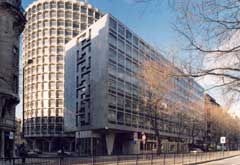 When English Heritage decides to add to its listed buildings rota, landlords across the country hold their breath. Listing could add iconic status to a building. It could also scupper, or at least delay and make more costly, any plans to redevelop it.
When English Heritage decides to add to its listed buildings rota, landlords across the country hold their breath. Listing could add iconic status to a building. It could also scupper, or at least delay and make more costly, any plans to redevelop it.
This week a handful of landlords were able to breathe a sigh of relief as eight of the 23 sites recommended for Grade II listed status failed to make the rota. The non-listing has unlocked hundreds of thousands of square feet of much-needed new development.
Among those excluded were Tower 42 (pictured), EC2; Bush Lane House, EC4; 150 Leadenhall Street, EC3; 6-8 Bishopsgate, EC2; and the NatWest Tower in Birmingham.
After the decision Rockspring and Sterling Property Ventures immediately applied to demolish the 22-storey NatWest Tower – a vacant brutalist 1976 block bought in November 2014. They are looking to replace it with a 200,000 sq ft, 35-storey tower.
Likewise, Stanhope, on behalf of the Mitsubishi Estate Company, will now lodge plans for up to 40 storeys at 150 Leadenhall Street and 6-8 Bishopsgate, while Tower 42 owner Nathan Kirsh can push ahead with his estate redevelopment plan.
Other landlords, including Bush Lane owner CCLA, have welcomed their freedom to enact future management plans.
But what about the 14 properties that were listed?
Three years after splashing £110m on CAA house, WC2, and 1 Kemble Street, WC2, Almacantar now has to deal with a Grade II listing on the property it had planned to redevelop.
The developer has experience with Grade II listed buildings at Centre Point, WC1, where this week it started work transforming the 1960s-built office skyscraper into an 82-flat scheme.
However, it remains on the fence about listing.
“While a listing will increase public recognition of their status as iconic examples of London’s rich architectural heritage, Almacantar is reviewing the detail of the decision from English Heritage before deciding on the next steps,” says a spokesman.
But former City of London chief planner Peter Rees is less guarded.
“One can largely assume that listed buildings, whatever their grade, will not be able to be redeveloped,” says Rees. “A landlord might be able to make some amendments to a property, if they are sympathetic to the listing, but will not be able to knock it down or make major alterations which affect the building’s character.”
And Chad Sutton, partner at law firm Maples Teesdale, warns that listing will extend planning timetables, potentially from 13 weeks to up to a year.
“The listing of a building can see planning timelines blown out of the water,” he says. “This is due to the extra complication of having to satisfy the local planning authority and English Heritage that the development will preserve and not be detrimental to the listed building.”
Red tape, whatever its form, is never welcomed by the development community, so while landlords that escaped the list this time have an opportunity to add space to a stock-starved market, those that had plans for sites that did make the list will have to get used to longer timelines, deeper pockets and potentially bigger headaches. But at least they can sleep easy knowing that their buildings will also have their place in the history books.
Grade II listed
Fourteen buildings were listed at Grade II this week:
- Brown Shipley, Moorgate, EC2
- 30 Cannon Street, EC4
- 1 Finsbury Avenue, EC2
- Civil Aviation Authority House, (formerly Space House), Kingsway, WC2
- Mountbatten House (formerly Gateway House), Basingstoke, Hampshire
- IBM Pilot Head Office, Cosham, Hampshire
- Gun Wharf, Chatham, Kent
- Former office of Ryder and Yates, Killingworth, Newcastle
- MEA House, Newcastle
- Bank House, King Street, Leeds
- Former Midland Bank, Dale Street, Liverpool
- St James House, Frederick Street, Birmingham
- Alpha Tower, Birmingham
- Former Central Electricity Generating Board Building, Bristol










